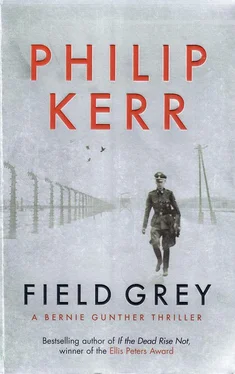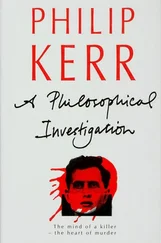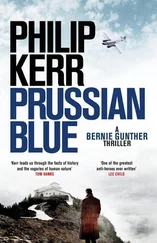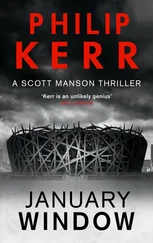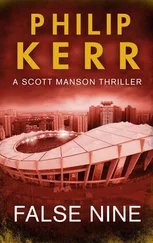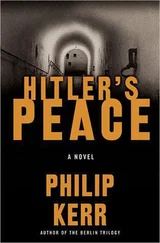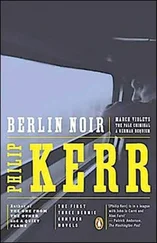Philip Kerr - Field Grey
Здесь есть возможность читать онлайн «Philip Kerr - Field Grey» весь текст электронной книги совершенно бесплатно (целиком полную версию без сокращений). В некоторых случаях можно слушать аудио, скачать через торрент в формате fb2 и присутствует краткое содержание. Жанр: Триллер, на английском языке. Описание произведения, (предисловие) а так же отзывы посетителей доступны на портале библиотеки ЛибКат.
- Название:Field Grey
- Автор:
- Жанр:
- Год:неизвестен
- ISBN:нет данных
- Рейтинг книги:3 / 5. Голосов: 1
-
Избранное:Добавить в избранное
- Отзывы:
-
Ваша оценка:
- 60
- 1
- 2
- 3
- 4
- 5
Field Grey: краткое содержание, описание и аннотация
Предлагаем к чтению аннотацию, описание, краткое содержание или предисловие (зависит от того, что написал сам автор книги «Field Grey»). Если вы не нашли необходимую информацию о книге — напишите в комментариях, мы постараемся отыскать её.
Field Grey — читать онлайн бесплатно полную книгу (весь текст) целиком
Ниже представлен текст книги, разбитый по страницам. Система сохранения места последней прочитанной страницы, позволяет с удобством читать онлайн бесплатно книгу «Field Grey», без необходимости каждый раз заново искать на чём Вы остановились. Поставьте закладку, и сможете в любой момент перейти на страницу, на которой закончили чтение.
Интервал:
Закладка:
After a few minutes I saw that we were driving west and breathed a sigh of relief. At least now I knew who was kidnapping me and why.
'Just sit back and enjoy the journey, my friend. From here on in, you're five star all the way. Those are my orders, Gunther, old buddy. I'm to treat you like a very important person.'
'That will make a pleasant change from when I was last a guest of you Americans,' I said. 'Frankly, there was something about it I didn't like.'
'And what was that?'
'My cell.'
CHAPTER THIRTY-SIX: GERMANY, 1954
Two and a half hours later we were in Frankfurt and heading across the Main into the north of the city. Our destination was an enormous, curving, honey-coloured marble office building with six square wings that lent the place a quasi- military aspect, as if any minute the clerks and secretaries inside might abandon their typewriters and comptometers and man some anti-aircraft guns on the flat roofs. I hadn't ever been there but I recognised it from old newsreels and picture magazines. Completed in 1930, the Poelzig Ensemble or Poelzig Complex had been the largest office building in Europe and the corporate headquarters of the I.G. Farben conglomerate. This former model of German business and modernity had been the centre for Nazi wartime research projects relating to the creation of synthetic oil and rubber, not to mention Zyklon B, the lethal gas used in death camps. It was now the headquarters of the US High Commissioner for Germany (the HICOG) and, it now seemed, the Central Intelligence Agency.
The car passed through a couple of military checkpoints before we parked and entered a temple-like portico. Behind this were some bronze doors and on the other side a capacious hallway with a large American flag, several American soldiers and two curving staircases covered with sheet aluminium. In front of the paternoster elevator I was invited to step aboard and to disembark on the ninth floor. A little nervously – for I had never before ridden one of these intimidating elevators – I complied.
The ninth floor was very different from those below. There were no windows. It was lit from skylights instead of banded glazing, which probably afforded the security-minded inhabitants yet more privacy. The ceiling was also much lower, which made me wonder if one of the qualifications to be an American spy in Europe might be a lack of height.
Certainly the man to whom I was now introduced was not tall, although he was hardly short, either. He wasn't anything you could have described, being unremarkable in almost every way. He was, I suppose, like an American professor, albeit one who spoke fluent German. He wore a blazer, grey flannel trousers, a button-down blue shirt, and some sort of club or academic tie – maroon with little shields. The introduction was not, however, illuminating, in that he appeared to have no name, just a title. He was 'the Chief and that was all I ever knew about him. I did however recognise the two men who were also waiting for me in that windowless meeting- room. Special Agents Scheuer and Frei – were those their real names? I still had no idea – waited until the Chief had acknowledged their presence before nodding at me with silent courtesy.
'Have you been here before?' he asked. 'I mean, when this building was owned by I.G. Farben.'
'No, sir.' I shrugged. 'As a matter of fact, I'm surprised to find it's still here. Apparently undamaged. A building this size, of such importance to the Nazi war effort, I'd always assumed it was bombed to rubble, like almost everything else in this part of Germany.'
'There are two schools of opinion on that, Gunther. Sit down, sit down. One school has it that the US Air Force was forbidden to bomb it because of the building's proximity to the Allied POW camp at Gruneburgpark. The other school would have you believe that Eisenhower had this building marked out as his future European headquarters. Apparently the building reminded him of the Pentagon, in Washington. And I suppose, if I'm honest, it does look a little similar. So maybe that's the real explanation after all.'
I drew a chair out from a long, dark wood table and sat down and waited for the Chief to get to the point of my being there. But it seemed he hadn't yet finished with Eisenhower.
'The president's wife wasn't quite so enamoured of this building, however. She took particular exception to a large bronze female figure – a nude that used to sit on the edge of the reflecting pool. She thought it wasn't suitable for a military installation.' The Chief chuckled. 'Which makes me wonder how many real soldiers she's actually met.' He frowned. 'I'm not sure where that statue went. The Hoechst Building, perhaps? That nude always did look like she needed some medicine, eh Phil?'
'Yes, sir,' said Scheuer.
'You must be tired after your journey, Herr Gunther,' said the Chief. 'So I'll try not to fatigue you any more than I have to. Would you like some coffee, sir?'
'Please.'
Scheuer moved towards a sideboard where coffee things had been neatly assembled on a tray.
The Chief sat down and regarded me with a mixture of curiosity and distrust. If there had been a chessboard on the table between us it might have made things feel a little easier for us both. All the same a game was in progress and we both knew what it was. He waited until Scheuer – Phil – had set a cup of coffee in front of me and then began.
'Zyklon B. I assume you've heard of it.'
I nodded.
'Everyone assumes it was developed by I.G. Farben. But they merely marketed the stuff. It was actually developed by another chemical company called Degesch, which came to be controlled by a third chemical company called Degussa. In 1930 Degussa needed to raise some money and so they sold half of their controlling interest in Degesch to their main competitor, I.G. Farben. And, by the way, the stuff, the actual crystals that exterminated insects with the speed of a cyclone, thus the name, well that was made by a fourth company called Dessauer Werke. You with me so far'
'Yes sir. Although I'm beginning to wonder why.'
'Patience, sir. All will be explained. So, Dessauer made the stuff for Degesch who sold the stuff to Degussa who sold the marketing rights to two other chemical companies. I won't even bother telling you their names. It would just confuse you. So, in fact, I.G. Farben held only a twenty per cent share in the gas, with the lion's share owned by another company, the Goldschmidt AG Company of Essen.
'Why am I telling you this? Let me explain. When I moved into this building I felt kind of uncomfortable at the idea that I might be breathing the same kind of office air as the folks who developed that poison gas. So I resolved to find out about it for myself. And I discovered that it really wasn't true that I.G. Farben had had very much to do with that gas. I also discovered that back in 1929, the US Public Health Service were using Zyklon B to disinfect the clothes of Mexican immigrants and the freight trains they were travelling in. At the New Orleans Quarantine Station. Incidentally, the stuff is still being manufactured today, in Czechoslovakia, in the city of Koln. They call it Uragan D2 and they use it to disinfect the trains that German POWs have been travelling on. Back to the Homeland.
'You see, Herr Gunther. I have a passion for information.
Some people call that sort of thing trivia, but I do not. I call that truth. Or knowledge. Or even, when I'm sitting in my office, intelligence. I have an appetite for facts, sir. Facts. Whether it's facts about I.G. Farben, Zyklon B gas, Mickey Messer, or Erich Mielke.'
I sipped my coffee. It was horrible. Like stewed socks. I reached for my cigarettes and remembered that I'd smoked the last of them in the car.
'Give Herr Gunther a cigarette, will you, Phil? That was what you were after, was it not?'
Читать дальшеИнтервал:
Закладка:
Похожие книги на «Field Grey»
Представляем Вашему вниманию похожие книги на «Field Grey» списком для выбора. Мы отобрали схожую по названию и смыслу литературу в надежде предоставить читателям больше вариантов отыскать новые, интересные, ещё непрочитанные произведения.
Обсуждение, отзывы о книге «Field Grey» и просто собственные мнения читателей. Оставьте ваши комментарии, напишите, что Вы думаете о произведении, его смысле или главных героях. Укажите что конкретно понравилось, а что нет, и почему Вы так считаете.
